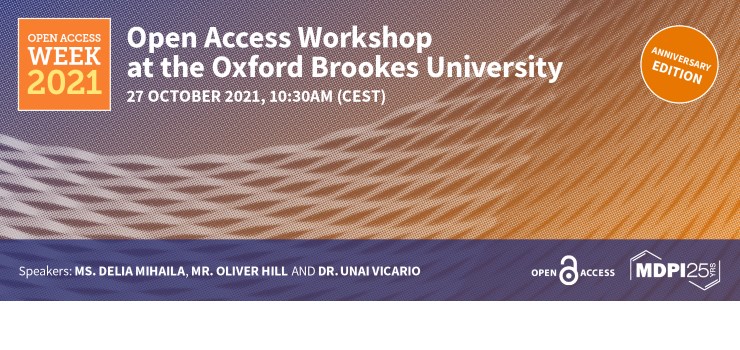Blog 25
These 25 years represent a quarter of a century of successful publication.25 Things You Didn’t Know About MDPI
Insight Faster
25 Things You Didn’t Know About MDPI
Introduction
MDPI has now been publishing the work of academics for twenty-five years, and its open access operations are helping to evolve the nature of research. There are many things, however, that may surprise you about the publisher.
1. MDPI wasn’t always a publisher
Twenty-five years ago, in 1996, MDPI began as a not-for-profit organisation, creating a collection of chemical compounds, a project started by founder Dr. Shu-Kun Lin.
2. Molecules was the first journal
As a way to promote his chemical compound collection, Dr. Lin created the journal Molecules in collaboration with publishing house Springer. He had already set up the Editorial Board and written the first editorial by 1995. In 1996, the first edition of Molecules was published. It was the very first MDPI journal, and one of the first electronic chemistry journals in existence. The journal turned out to be highly successful, and MDPI subsequently took over full control from Springer. A second journal, International Journal of Molecular Sciences (IJMS), was then planned in 1998.
3. The organisation has two names
Although the acronym MDPI has always been the cornerstone of the institute’s identity, it previously stood for something else: Molecular Diversity Preservation International, based on its history as a chemical compound collection. This organisation is still around today, but a separate legal entity exclusively for the journals was created in 2010—Multidisciplinary Digital Publishing Institute (MDPI AG).
4. The company is quickly growing
MDPI employs over 4000 people internationally, including English editors, assistant editors, publishing and marketing staff. Of these 4000+, over 1700 were recruited in 2020, an 82% increase. The workforce continues to grow. The overall growth of MDPI is 42.27% each year, with 323 peer-reviewed journals so far.
5. There are offices in 11 countries
The MDPI headquarters are in Basel, Switzerland, and its 14 offices are located in 3 different continents. The newest office, in Toronto, Canada, opened in 2020. There are also offices in Barcelona, Spain; Tokyo, Japan; Cluj, Romania; Bucharest, Romania; Belgrade, Serbia; Novi Sad, Serbia; Manchester, England; Krakow, Poland; Singapore; Tianjin, China; Wuhan, China; and two offices in Beijing, China.
6. The authorship is global
As well as having a physical presence around the world in terms of offices, MDPI’s authorship is truly diverse, with submissions from everywhere you can imagine. In 2020, 42.7% of authors were from institutions in Europe, 24.1% from East Asia, 14.2% from North America and 19% from elsewhere.
7. Under half of the submissions are accepted
Overall, 381,100 submissions were received in 2020, for which the rejection rate was 57%. Not all papers are appropriate for the journal, collection or Special Issue to which they have been submitted, and not all submitted research reflects MDPI’s core values.
8. MDPI organises conferences
Sciforum is MDPI’s conference organisation platform. Scientists from around the world use it to search for conferences organised by MDPI and its associates, as well as plan their own conferences using the platform. Over the years, MDPI has hosted 300 events (including physical and online conferences), whilst 32 conferences were held virtually in 2020.
9. MDPI publishes the greatest number of open access papers
In 2020, MDPI published the most open access papers of any academic publisher (https://www.scilit.net/rankings), becoming the distinct leader of the open access revolution. This is at the centre of MDPI’s philosophy, with the belief that open access enables collaborative research across disciplines and continents.
10. MDPI has its own submission system
SuSy (Submission and Manuscript Handling System) is MDPI’s online manuscript service that allows authors to upload their papers and track the progress of their publications. SuSy was launched in 2011 and helps to ensure a smooth process for authors and editors. On a larger scale, the software built into SuSy, called XML (Extensible Markup Language) software, allows the submitted documents to be easily transitioned to other versions, enabling cross-linked references, a uniform layout, and higher quality PDF and HTML versions of papers.
11. MDPI has a journal finder tool
If authors are struggling to find where their manuscript fits within the numerous scopes in MDPI’s hundreds of journals, they can access the Journal Finder, created to quickly help authors find the most relevant journal and save them time in the submission process.
12. A Preprints service is available for papers before submission
Preprints.org is a multi-disciplinary platform for the early showcasing of articles in all research fields. Since 2016, the site has been open for scientists to post a first look of their manuscripts. Others can comment on their work using the site’s features, and versions are tracked over time, as well as many other features that give academics flexibility when it comes to their preprints.
13. MDPI shares its submission system with institutional publishers
MDPI’s Journal and Article Management System (JAMS.pub) was previously only ever used for MDPI paper publication; that is, until 2017, when MDPI started to offer the system to institutional publishers (e.g., UCL—University College London). JAMS is a comprehensive service that includes a shared submission website, journals hosted at a URL of the publisher’s choice, and a full production service.
14. All journals have quick publication rates
Inspired by lightning advances in innovation and technology, MDPI aims to have papers published as quickly as possible. There is an average of three weeks from submission to first decision. In general, 5–7 weeks is all the time it takes from submission to publication.
15. MDPI has several initiatives for academics
As well as Sciforum for conferences, MDPI has many other initiatives to help further research and innovation. These include Sciprofiles (https://sciprofiles.com/), a social network for researchers, Scilit (https://www.scilit.net/), a searchable comprehensive database of research studies, Preprints (https://www.preprints.org/), a free (not-for-profit) open access multidisciplinary preprint platform, and Encyclopedia (https://encyclopedia.pub/), an online reference created and curated by active scholars.
16. Authors can publish books
MDPI publishes open access online books for academic authors, which can also be printed on demand. The publisher has a deep-rooted network of vendors across the world and facilitates thorough indexing in databases such as the Directory of Open Access Books (DOAB). You can also compile published articles from any MDPI journal into a book using MDPI’s Book Builder for you to download and to order physical copies of it via print-on-demand.
17. MDPI has its own content aggregator platform
In 2013, MDPI started its own content aggregator platform called Scilit. The database uses sourcing and merging publication metadata from DOAJ, CrossRef and PubMed, a comprehensive and convenient tool to search scientific literature. New articles are cataloged within hours, providing an up-to-date and complete resource for scholars.
18. Numerous collaborations with societies are established each year
MDPI currently supports more than 140 learned societies and organisations, ranging from affiliations to publishing journals on behalf of the society. When the society decides to partner with us to publish their journal, they retain ownership of their publication, while MDPI handles finances, marketing and archiving, and provides a practical platform for submission and management. MDPI is flexible when it comes to discussing the terms of these collaborations and works to adapt to the needs of each society. More information can be found at https://0-www-mdpi-com.brum.beds.ac.uk/societies.
19. The publisher hosts a writing competition
Each year, the MDPI Writing Prize is granted, with prize money awarded to winners. For this year’s prize, entrants must write 1000 words on how the COVID-19 pandemic has affected their research.
Information on how to enter can be found here: https://0-www-mdpi-com.brum.beds.ac.uk/about/announcements/2523.
20. MDPI offers awards to scholars
Each MDPI journal offers awards for excellence and innovation, with monetary prizes and travel grants available for winners. Authors can enter themselves, or in some cases, be nominated by their peers. Over 500 prizes have been awarded since 2016, and 396 awards are currently open for application.
21. MDPI offers two types of editing
Standard editing and specialist editing are both offered by MDPI, and both authors and non-authors alike are welcome to use the services. Standard editing involves checking the grammar and spelling of papers, whereas specialist editing is more subject-specific and involves an analysis of the structure and clarity of the manuscript.
22. Most articles published are indexed
As 160 of MDPI’s journals are currently indexed in Web of Science (82 in SCIE), overall, 96% of papers are available in Web of Science. As well as this, 160 journals are indexed in Scopus, and 72 in PubMed.
23. MDPI awards 100,000 USD each year as part of the World Sustainability Award
Over the past 25 years, MDPI founder Dr. Shu-Kun Lin’s interest in sustainability has increased considerably. Both he and the whole of MDPI are strongly committed to supporting research that is relevant to society and that contributes to regional and global efforts towards a sustainable world. As part of this effort, MDPI set up both the MDPI Sustainability Foundation and the World Sustainability Forum (WSF) in 2011.
MDPI and the Foundation offer two large prizes to support sustainable development. A monetary award of 100,000 USD (World Sustainability Award) is granted by the MDPI Sustainability Foundation, whereas an award of 20,000 USD (Emerging Sustainability Leader Award) is granted by the MDPI journal Sustainability. Both awards are presented at each of the World Sustainability Forum events (https://wsf-9.sciforum.net/).
24. There is no limit to the length of research papers
Any number of words can be submitted as part of a manuscript. Papers longer than 10,000 words should be discussed with MDPI in advance, but they will still be considered for acceptance to the selected journal.
25. More people than ever are reading MDPI journals
Visits to MDPI’s website increase every year, with 24.2 million users visiting in 2019, and 44.4 million in 2020. The site had over 225 million page views in 2020 alone.


